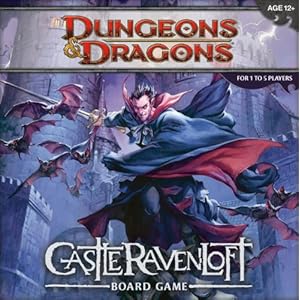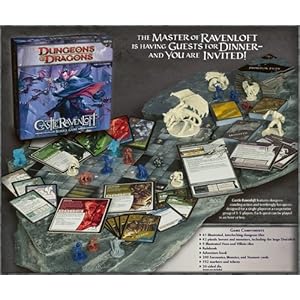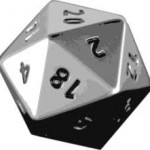 After hearing it plugged on the Wizards of the Coast D&D podcast, I made the Dungeons & Dragons: Castle Ravenloft Board Game
After hearing it plugged on the Wizards of the Coast D&D podcast, I made the Dungeons & Dragons: Castle Ravenloft Board Game a last-minute addition to my Christmas Wishlist this past year despite concerns that the “Dungeons & Dragons” would scare most of my friends away from giving it a try. To my pleasant surprise, I received it and have already played a number of enjoyable games. Not only has Castle Ravenloft been well-received by my D&D gamer-friends, but even by those who had never seen a d20 before – a huge testament to the accessibility of the game and its ability to rise above and beyond the stigma sometimes associated with Dungeons & Dragons. Originally retailing for $65, the price has since dropped to $45 on Amazon.com
An exciting D&D boardgame for 1–5 players. The master of Ravenloft is having guests for dinner—and you are invited! Evil lurks in the towers and dungeons of Castle Ravenloft, and only heroes of exceptional bravery can survive the horrors within. Designed for 1–5 players, this boardgame features multiple scenarios, challenging quests, and cooperative game play.
Included Components – 8.5
 • 40 plastic heroes and monsters: color-coded for quick identification(no digging through pieces)
• 40 plastic heroes and monsters: color-coded for quick identification(no digging through pieces)
• 13 sheets of interlocking cardstock dungeon tiles: thick cardstock will allow for repeated handling
• 200 encounter and treasure cards: thick cardstock keeps the cards from easily bending and prevent them from blowing away (you’ve all had a sneeze like that, admit it)
• Rulebook
• Scenario book
• 20-sided die
Though the materials supplied are adequate in terms of quality as well as quantity, there is no explanation as to what some of the elements are used for. Yes, the miniatures are color-coded, but for the rest of the pieces, only by playing the game, do you discover that there are special pieces unique to individual adventures. Not a big deal, but something that could have been addressed to save us some confusion.
Mechanics/Ease of Play – 9.0
It’s fun and really easy – there’s just 3 things to do on my turn – My wife, Gwen
That quote from my wife, though an oversimplification, is really a great indicator for the simple, but enjoyable mechanics that drive the gameplay of Castle Ravenloft and drive-home the point that you don’t have to know anything about Dungeons & Dragons to have a great time(though you’ll certainly be a step ahead if you’re already familiar with the d20 system).
Setup
The included scenario book provides about 20 varied adventures for the players (from 1 to 5 of them) to tackle cooperatively. Each scenario has a set of victory and failure conditions that tie each of the Heroes(as the players are called) together in pursuit of a specific goal. Each scenario has specific directions to facilitate crafting the game board appropriately. In general, the dungeon(game board) is pieced together at the players direction as tiles, monsters, encounters and treasures are drawn randomly from shuffled piles. Not only does this provide for some great replay value, but it also adds an element of suspense as players have no idea what is lurking around the “next corner”.
Each player chooses one of the 5 provided heroes to play during the course of the scenario: Cleric, Fighter, Ranger, Rogue or Wizard. Each of the heroes has a corresponding “hero tile” that contains all of the details specific to that “class”. Of particular note are the values for Armor Class(AC), Speed, Hit Points(HP) and Surge Value(a concept Wizards of the Coast first introduced with D&D 4e). Each player then chooses a set of 4 to 6 “powers” from a deck of about 10 hero-specific cards. Each deck consists of various at-will, daily and utility powers. At-will powers can be used repeatedly throughout the scenario, whereas daily and utility powers are expended upon use and only brought back into play by certain treasure items. Helpfully, Wizards included a “recommended” list of power card for each hero that I have found to be very effective, while still providing advanced players with the opportunity to “fine tune” their powers based on specific scenarios.
Your turn
Players collectively decide who will go first and play then goes around the table. Each turn consists of three “phases” that dictate the flow of each turn:
The Hero Phase
The first part of your turn, the hero phase is just what it sounds like – where the Hero takes the spotlight. During this phase you will be moving your hero miniature around the game board and attacking monsters that you discover. You can use one “attack” power card per turn, as well as utility powers as indicated by the description. Your movements are nearly as important as your attacks, allowing you to “explore” new areas of the dungeon in the exploration phase to follow, avoid traps, or flee from monsters. The relatively small number of powers to choose from combined with simple rules for movement makes your choices feel meaningful without getting bogged down in a tedium of rules deliberation. I found the powers very easy to use, while maintaining the elements of choice so important to the RPG genre.
Based on the d20 system, each attack involves rolling a twenty-sided die, adding a modifier and comparing the result to the Armor Class(AC) of the target. If the roll plus modified is equal or greater than the AC, your attack hits the target and deals damage; otherwise, your attack misses and usually has no effect.
The Exploration Phase
The dungeon is built primarily in the exploration phase based on your actions during the Hero phase based on the concept of an “unexplored edge”. Simply put, any dungeon tile edge that is not depicted as a wall, nor already connected to another dungeon tile is considered to be an “unexplored edge” and thus, ripe for hero exploration. If the hero phase ends with your miniature positions adjacent to an unexplored edge, you draw a new dungeon tile and place it next to your hero. In addition, you draw a card from the “Monster” deck and place the appropriate miniature on the new tile on top of the pile of skulls that each dungeon tiles has. Each of the Monster cards has all of the stats(AC, HP) and tactics(how it attacks and moves) listed similar to the Hero tiles that you choose from before the game starts. This is important – in Castle Ravenloft YOU will control each of the monsters that you draw from the deck until they are killed by your party of heroes(or less-pleasantly, until you are killed by them).
The Villain Phase
If you did not draw a new dungeon tile during the exploration phase or if you drew a dungeon tile marked with a black triangle (anecdotally about 50% of the tiles are black and 50% are white, though I haven’t actually counted them) you will also draw an “Encounter” card. These Encounter cards are always negative events, that will impact one or more of the heroes in some way. Most encounters are some type of attack against all heroes in the current heroes dungeon tile; this could be a one-time attack, or it could be a persistent “trap” device that is activated along with monsters you may also control. In addition to straight-up attacks, you can also find “Environment” effects that last until another “Environment” card is drawn – these can do anything from reducing all heroes’ speed by 1 to forcing you to roll twice for every attack and use the lower result. These cards can be quite devastating when the heroes are clumped together on the same tile, so they force you to spread out or risk a catastrophic event. During gameplay, the Encounters really increased the pacing and level of urgency.
After you determine that an Encounter card should/should not be drawn, you activate all of the monsters and traps under your control in the order they were drawn. Far less arbitrary than it sounds, a player reads the concise “tactics” for each Monster or Trap
The d20
 Ah, the d20 (20-sided die) – bringer of fortune and failure alike – it is the foundational element in Castle Ravenloft and what really ties the mechanics to Dungeons & Dragons.
Ah, the d20 (20-sided die) – bringer of fortune and failure alike – it is the foundational element in Castle Ravenloft and what really ties the mechanics to Dungeons & Dragons.
Fun Factor – 8.0
Despite a somewhat slow start(due to setup, reading/explaining the “adventure”, etc.), the game quickly picks up the pace into what can only be described as a frantic, entertaining fight to survive that only ends when you’ve completed the heroic objective or have died trying! Your success (or failure) is based almost entirely on how well (or poorly) you managed the constant barrage of monsters, traps, and events that are thrown at the party. Fail to control the onslaught and you will be quickly overrun as the monsters reach an unstoppable critical mass.
The designers have done an excellent job of making every adventure take you to cusp of destruction when you finally reach your objective and (hopefully) emerge from the Castle Ravenloft dungeons as victorious heroes.
However, after a few games I did find that my selection of actions(during the Hero phase) seemed to grow less interesting. A larger selection of power cards would be a welcomed addition and would likely remedy this minor drawback.
Craftsmanship/Art – 7.0
The craftsmanship is at a higher level than I expected(due to low expectations), but seems appropriate considering the cost of the game. The game tiles and hero cards, in particular, have a nice weight to them that lends to the impression of high-caliber materials. One notable exception, are the miniatures – outside of the “main bad guys”(which have decent quality), the miniatures seem cheap and prone to breakage. The hero miniatures in particular, bend easily and one or two of them fall over easily. This is one area for improvement, especially considering the cost of the game.
The art direction is consistent with the rest of the Dungeons & Dragons product line. For those not familiar, it is fairly typical fantasy art with an emphasis on “realistic portrayal”, as opposed to the over-exaggerated caricatures found in anime, etc. Suitable for developing the mood of the game, I found it to be quite adequate – nothing more, nothing less.
There was a lot of room for Wizards to “WOW!” me with the craftsmanship and art here – sadly, they didn’t take full advantage. It’s more of a “nitpick” for me, but as the only real “flaw” in the game, I felt it is worth mentioning.
Replay Value – 9.0
The very nature of the game(building the game board as play progresses) results in a new experience every time, even when playing the same “adventure”. Combinations of hero classes and the inclusion of 20 unique adventures provide abundant material for even the most avid gamer. I have owned the game for over a year now and have yet to even play through all of the adventures once, much-less play through them repeatedly.
Unlike many board games that fall into predictable patterns of play, the designers of Castle Ravenloft have managed to create a game that feels familiar to those with experience without succumbing to repetition, boredom, and ultimately disinterest.
If you and your gaming group are looking for a game to hold your interests through multiple gatherings, Castle Ravenloft is one that I highly recommend!
Conclusion – 8.3 Great! Highly Recommended Purchase.
The mechanics and replay value really set Dungeons & Dragons: Castle Ravenloft apart from other games and serve to polish and balance the “meh” art and craftsmanship that would have otherwise detracted from the overall appeal. A job well done and an excellent addition to your gaming repertoire that will last through many gatherings. As an added benefit, Ravenloft also serves as a great tool for introducing otherwise hesitant friends to the Dungeons & Dragons RPG – which otherwise has a fairly high learning curve.
Questions
Have you played Castle Ravenloft? I’d love to know what you thought of it in the comments.
Considering picking up the game, but have questions that my review didn’t cover? Let me know in the comments and I’ll dig up the answer for you.

3 thoughts on “Castle Ravenloft Board Game Review”
I have noticed you don’t monetize your site, don’t waste your traffic, you can earn additional bucks every month
because you’ve got high quality content. If you want to know how to make extra $$$, search for: Ercannou’s essential adsense alternative
I have checked your site and i’ve found some duplicate
content, that’s why you don’t rank high in google, but there is a tool that can help you to create 100% unique
articles, search for: SSundee advices unlimited content for your
blog
Activities: Whenever an application displays a display screen to the person,
that’s an activity. We’ll be taught extra about the appliance development course of in the subsequent section.